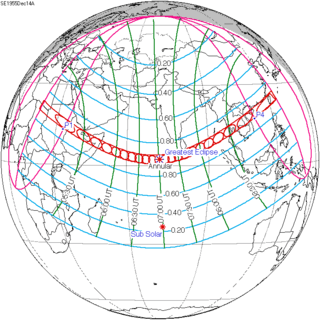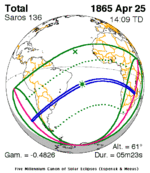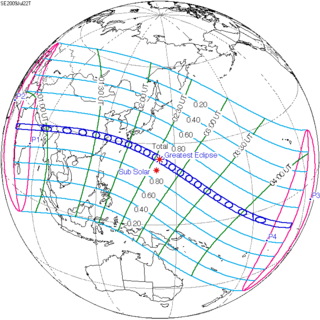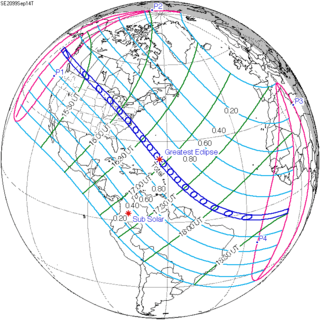Solar eclipse of June 20, 1955
| Solar eclipse of June 20, 1955 | |
|---|---|
 Map | |
| Type of eclipse | |
| Nature | Total |
| Gamma | -0.1528 |
| Magnitude | 1.0776 |
| Maximum eclipse | |
| Duration | 428 sec (7 m 8 s) |
| Coordinates | 14°48′N 117°00′E / 14.8°N 117°E |
| Max. width of band | 254 km (158 mi) |
| Times (UTC) | |
| Greatest eclipse | 4:10:42 |
| References | |
| Saros | 136 (34 of 71) |
| Catalog # (SE5000) | 9410 |
A total solar eclipse occurred on June 20, 1955. A solar eclipse occurs when the Moon passes between Earth and the Sun, thereby totally or partly obscuring the image of the Sun for a viewer on Earth. A total solar eclipse occurs when the Moon's apparent diameter is larger than the Sun's, blocking all direct sunlight, turning day into darkness. Totality occurs in a narrow path across Earth's surface, with the partial solar eclipse visible over a surrounding region thousands of kilometres wide. With a maximum duration of 7 minutes 8 seconds, this is the longest solar eclipse of saros series 136, as well as the longest total solar eclipse since the 11th century, and until the 22nd century.[1] Totality beginning over the Indian Ocean and Maldives, crossing southern tip of India and Sri Lanka, moving across Indochina and the Philippines (near the greatest eclipse), towards Solomon Islands ending over Southwestern Pacific Ocean.
Related eclipses
Solar eclipses of 1953-1956
Each member in a semester series of solar eclipses repeats approximately every 177 days and 4 hours (a semester) at alternating nodes of the Moon's orbit.
Note: Partial solar eclipse of February 14, 1953 and August 9, 1953 belong to the last lunar year set.
| Solar eclipse series sets from 1953–1956 | ||||
|---|---|---|---|---|
| Descending node | Ascending node | |||
| Saros | Map | Saros | Map | |
| 116 |  July 11, 1953 Partial |
121 |  January 5, 1954 Annular | |
| 126 |  June 30, 1954 Total |
131 |  December 25, 1954 Annular | |
| 136 |  June 20, 1955 Total |
141 |  December 14, 1955 Annular | |
| 146 |  June 8, 1956 Total |
151 |  December 2, 1956 Partial | |
Saros 136
Solar Saros 136, repeating every 18 years, 11 days, contains 71 events. The series started with partial solar eclipse on Jun 14, 1360, and reached a first annular eclipse on September 8, 1504. It was a hybrid event from November 22, 1612, through January 17, 1703, and total eclipses from January 27, 1721 through May 13, 2496. The series ends at member 71 as a partial eclipse on July 30, 2622, with the entire series lasting 1262 years. The longest eclipse occurred on June 20, 1955, with a maximum duration of totality at 7 minutes, 8 seconds.[2]
| Series members 29–43 occur between 1865 and 2117 | ||
|---|---|---|
| 29 | 30 | 31 |
 April 25, 1865 |
 May 6, 1883 |
 May 18, 1901 |
| 32 | 33 | 34 |
 May 29, 1919 |
 Jun 8, 1937 |
 Jun 20, 1955 |
| 35 | 36 | 37 |
 Jun 30, 1973 |
 Jul 11, 1991 |
 Jul 22, 2009 |
| 38 | 39 | 40 |
 Aug 2, 2027 |
 Aug 12, 2045 |
 Aug. 24, 2063 |
| 41 | 42 | 43 |
 Sep. 3, 2081 |
 Sep. 14, 2099 |
 Sep. 26, 2117 |
Notes
- ↑ Fred Espenak. "Catalog of Solar Eclipses: 1001 to 1100". NASA.
- ↑ SEsaros136 at NASA.gov
References
- Earth visibility chart and eclipse statistics Eclipse Predictions by Fred Espenak, NASA/GSFC
- Photometry of the Solar Corona at the Eclipse on June 20, 1955, Publications of the Astronomical Society of Japan, vol. 8, p.126 (1956).
- Nasa.gov
| Wikimedia Commons has media related to Solar eclipse of 1955 June 20. |
